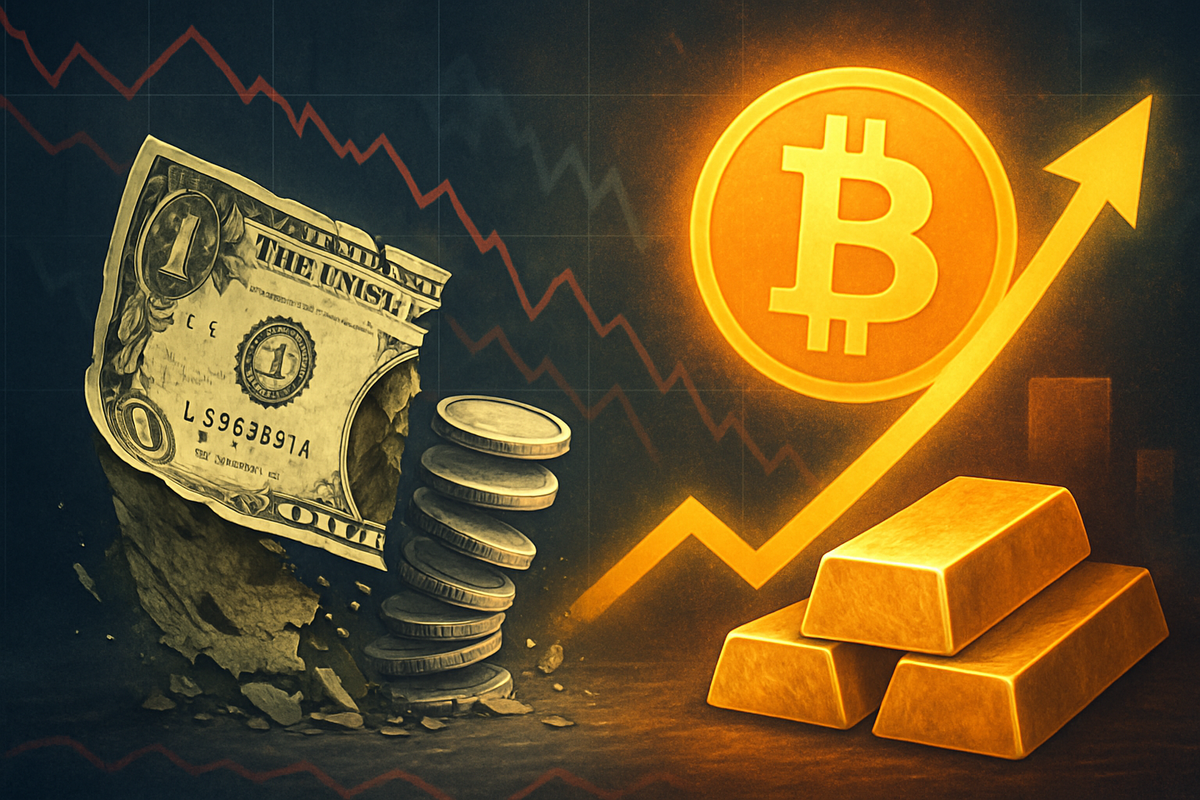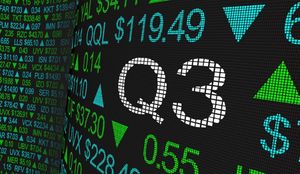
New York, NY – October 7, 2025 – In a significant and concerning development for global financial markets, Citadel CEO Ken Griffin has issued stark warnings about a growing trend of investors abandoning the U.S. dollar in favor of alternative assets like Bitcoin and gold. Griffin's remarks, made public around the current date, highlight a profound shift in investor confidence, driven by persistent inflation, the dollar's depreciation, and escalating U.S. debt, which he describes as a "debasement trade" and an economy on a "sugar high."
This exodus from the greenback signals a deepening distrust in traditional monetary systems and U.S. fiscal stability. The immediate implications are already visible, with gold prices soaring past $3,900 and even touching $4,000 per ounce, while Bitcoin has surged to unprecedented highs exceeding $125,000 to $126,000. This dramatic re-allocation of capital underscores a fundamental redefinition of trust, as investors seek refuge in assets perceived to be independent of sovereign promises and immune to governmental fiscal policies.
Citadel CEO Ken Griffin Sounds Alarm on Dollar Exodus
Citadel CEO Ken Griffin's recent pronouncements have sent ripples across the financial world, painting a vivid picture of a market grappling with unprecedented shifts. Speaking around October 7, 2025, Griffin articulated his deep concerns over investors' increasing inclination to "de-dollarize" their portfolios, actively seeking to "de-risk" against perceived U.S. sovereign vulnerabilities. His warnings are not merely speculative but are grounded in tangible market movements, with both gold and Bitcoin experiencing parabolic rises. Gold, a perennial safe haven, has smashed through previous records, trading well above $3,900 and at times exceeding $4,000 per ounce. Simultaneously, Bitcoin, the flagship cryptocurrency, has demonstrated "unbelievable" appreciation, vaulting to new all-time highs above $125,000 to $126,000.
The timeline leading up to this moment reveals a confluence of macro-economic pressures. The U.S. dollar has seen an approximate 10% decline year-to-date in 2025, marking its most dismal performance in decades and representing the largest six-month depreciation in 50 years. This precipitous drop comes against a backdrop of inflation remaining "substantially above target" and projected to persist into 2026. Furthermore, the U.S. economy, according to Griffin, is on a "sugar high," sustained by fiscal and monetary stimulus measures typically reserved for recessions, yet these are fueling widespread asset inflation without a corresponding healthy economic expansion.
Key players in this unfolding narrative include Ken Griffin himself, leading one of the world's most influential hedge funds, Citadel. His warnings carry significant weight, influencing institutional investors and market sentiment globally. The investors making these moves, ranging from large institutions to retail participants, are the direct drivers of the capital shift. Initial market reactions have been swift and decisive: a demonstrable flight to quality in non-fiat assets, a clear signal of diminishing confidence in the dollar's long-term stability, and a growing acceptance of Bitcoin as a legitimate hedge against inflation and fiscal imbalance, elevating it to a "core component of institutional strategy." The U.S. government and the Federal Reserve are also central stakeholders, as their fiscal and monetary policies are directly implicated in the dollar's weakening position and the broader erosion of investor trust. The looming specter of a U.S. government shutdown and record public debt exceeding $35 trillion further exacerbates these concerns, underscoring the urgent need for fiscal discipline and policy clarity.
Winners and Losers in the De-Dollarization Shift
The profound investor shift away from the U.S. dollar towards Bitcoin and gold is poised to create a clear delineation of winners and losers across various industries, fundamentally altering business models and market valuations. This "de-dollarization" trend, driven by a quest for hedges against fiscal instability and currency debasement, will disproportionately benefit companies directly involved in the production and facilitation of these alternative assets.
Gold Mining Companies stand to be primary beneficiaries. As the demand for physical gold surges, leading to historically high prices (surpassing $3,900 and even $4,000 per ounce), the core business of extracting and selling gold becomes immensely more profitable. Companies like Newmont Corporation (NYSE: NEM), one of the world's largest gold producers, and Barrick Gold Corporation (NYSE: GOLD), a major global gold and copper miner, are seeing their revenues and profit margins expand significantly. Similarly, Agnico Eagle Mines Limited (NYSE: AEM) and Kinross Gold Corporation (NYSE: KGC) are experiencing heightened profitability, enabling them to accelerate development projects and potentially return more capital to shareholders. Gold-focused royalty and streaming companies such as Franco-Nevada Corporation (TSX: FNV) and Wheaton Precious Metals Corp. (TSX: WPM) also benefit immensely, as their revenue streams are directly tied to the price of precious metals.
On the cryptocurrency front, Cryptocurrency Exchanges are positioned for substantial gains. The surge in Bitcoin's value and its increasing adoption as an institutional hedge translate directly into higher trading volumes and new user acquisition for platforms like Coinbase Global, Inc. (NASDAQ: COIN). These exchanges generate revenue through trading fees, listing fees, and other services, all of which are bolstered by increased market activity. While not an exchange, MicroStrategy Incorporated (NASDAQ: MSTR), a business intelligence company with a significant corporate treasury investment in Bitcoin, sees its stock performance heavily correlated with Bitcoin's price, making it a clear winner in this scenario. Companies like Bakkt Holdings, Inc. (NYSE: BKKT) and even cryptocurrency mining operations like Argo Blockchain plc (LSE: ARBKF) also benefit from the appreciating value and increased interest in digital assets.
Conversely, Traditional Financial Services Companies face significant challenges and a pressing need for adaptation. Major global banks such as JPMorgan Chase & Co. (NYSE: JPM), Bank of America Corporation (NYSE: BAC), and Citigroup Inc. (NYSE: C) could experience reduced global demand for U.S. dollars, impacting transaction fees and profits from facilitating dollar-denominated trade. A shift away from traditional bank deposits to alternative assets, including stablecoins, could also erode their deposit bases. Similarly, large asset managers like BlackRock, Inc. (NYSE: BLK) could see reduced assets under management (AUM) in their traditional dollar-denominated stock and bond portfolios if investors bypass these for direct holdings in gold or Bitcoin. However, many of these institutions are not passively observing; they are actively adapting by launching Bitcoin ETFs, gold ETFs, and exploring cryptocurrency settlement capabilities, as seen with Visa Inc. (NYSE: V) and Mastercard Incorporated (NYSE: MA). Their ability to innovate and integrate these new asset classes will determine their long-term success in this evolving financial landscape.
A Seismic Shift: De-Dollarization and Its Global Ramifications
The investor flight from the U.S. dollar towards Bitcoin and gold is not merely a short-term market fluctuation; it signifies a seismic shift within the global financial architecture, deeply intertwined with broader trends of de-dollarization. This phenomenon, where nations and institutions actively seek to reduce their reliance on the U.S. dollar, is gaining momentum due to a confluence of factors: heightened political polarization in the U.S., which threatens governance stability; punitive tariff policies; and the weaponization of the dollar through sanctions, as exemplified by the freezing of Russia's currency reserves. Simultaneously, the growing economic influence of blocs like BRICS, coupled with the exploration of alternative trade settlement mechanisms in currencies like the yuan, further chips away at the dollar's long-held dominance. Investors are increasingly engaging in a "debasement trade," using assets with scarce supply, like gold and Bitcoin, as a hedge against the perceived devaluation of fiat currencies, especially in an era of ballooning government debt and persistent inflation.
The ripple effects of such a significant shift would be profound, particularly for the U.S. economy. A sustained de-dollarization would likely lead to a broad depreciation and underperformance of U.S. financial assets, including equities and fixed income. The U.S. would stand to lose its "exorbitant privilege" – the ability to finance large government and trade deficits cheaply due to global demand for its currency. This could result in higher borrowing costs, exacerbating the national debt crisis and potentially exposing the economy to severe shocks. While a weaker dollar might benefit American exporters, it simultaneously makes imports more expensive, impacting consumer purchasing power. Globally, a diminished dollar could disrupt the existing economic balance, creating pressures for countries holding vast dollar reserves and potentially reinforcing the formation of economic "blocs" aligned with geopolitical interests, thereby increasing the risk of financial instability.
From a regulatory and policy perspective, the increasing adoption of Bitcoin and gold as alternatives presents a complex landscape. For cryptocurrencies, a lack of standardized, global regulatory frameworks creates ambiguity and poses risks related to market manipulation, fraud, and systemic instability. Governments and financial institutions are grappling with how to integrate these assets without compromising financial stability. Central banks, traditionally conservative, are already diversifying their reserves into gold at an accelerating pace, with some analysts even predicting Bitcoin's inclusion in official reserve balance sheets by 2030, assuming its volatility can be managed through regulatory maturation. This necessitates policy clarity and fiscal discipline from governments, particularly the U.S., to restore trust in traditional financial instruments and potentially mitigate the accelerated flight to alternatives. The U.S. government's recent efforts to regulate stablecoins and ease the environment for exchange-traded products suggest a recognition of the need to integrate digital assets into the mainstream, but the pace of such integration remains critical.
Historically, transitions between dominant global reserve currencies have often been tumultuous. The shift from the British pound sterling to the U.S. dollar in the 20th century, driven by America's ascendance as an economic powerhouse, occurred over decades and was punctuated by two world wars. Before that, the Dutch Guilder, and the French and Spanish currencies each held sway. The "Nixon Shock" of 1971, which decoupled the dollar from gold, serves as another poignant precedent, demonstrating how fundamental changes to monetary policy can significantly revalue gold and other assets. These historical parallels underscore that while the dollar's reign may be challenged, a smooth, orderly transition to a new global monetary order is far from guaranteed, potentially ushering in a period of heightened geopolitical tensions and economic uncertainty.
The Road Ahead: Navigating a Multipolar Financial Landscape
The investor exodus from the U.S. dollar, as highlighted by Ken Griffin, heralds a transformative period for global finance, setting the stage for both significant challenges and unprecedented opportunities. The short-term outlook, spanning the remainder of 2025 into early 2026, suggests a continuation of the trends already in motion. Gold prices are projected to maintain their upward trajectory, potentially exceeding $4,000 per ounce by year-end and even reaching $4,200-$4,500 in 2026, buoyed by persistent inflation, geopolitical instability, and expectations of Federal Reserve rate cuts. Bitcoin, having already surpassed $125,000, is anticipated to see further gains, with some analysts forecasting it could hit $135,000 in the near term and possibly $200,000 by the end of 2025. This appreciation will be accompanied by increased market volatility as new price levels are established. Crucially, both assets are expected to attract sustained institutional inflows, particularly Bitcoin, whose Spot ETFs have become a significant catalyst for capital allocation and diversification strategies. The accelerating de-dollarization momentum, fueled by U.S. fiscal concerns and geopolitical realignments, will likely see central banks further diversifying their reserves, with the dollar's share already falling below 47% by April 2025.
Looking beyond 2026, the long-term possibilities point towards a fundamental reordering of the global monetary system. A gradual de-dollarization is expected to usher in a multipolar currency system, where the U.S. dollar shares its reserve currency role with other major currencies like the Euro and Chinese Yuan, alongside alternative assets such as gold and Bitcoin. Gold is poised to cement its role as a core reserve asset, with central banks continuing aggressive accumulation to safeguard against inflation and geopolitical vulnerabilities, and some ambitious forecasts even suggesting a price of $10,000 by the end of the decade. Bitcoin, with its fixed supply and decentralized nature, will increasingly be viewed as "digital gold," a non-sovereign hedge against monetary debasement. This redefinition of trust, moving away from traditional monetary systems, will necessitate strategic pivots from all stakeholders.
Governments and central banks, particularly the U.S., will be compelled to demonstrate stronger fiscal discipline and policy clarity to restore confidence in dollar-denominated assets. Global central banks will continue reserve diversification, potentially accelerating the integration of digital assets and Central Bank Digital Currencies (CBDCs) into their strategic frameworks, reflecting a shift towards digital sovereignty. Financial institutions and corporations must adapt by diversifying their hedging strategies beyond traditional currency pairs to include gold and digital assets, while re-evaluating asset allocations in investment portfolios. Investment in new payment technologies and blockchain infrastructure will become critical to facilitate transactions in a wider array of currencies and digital assets.
Market opportunities will emerge in the form of new investment products, such as Bitcoin ETFs and tokenized gold, which have already seen significant growth. The "debasement trade" will continue to offer appreciation potential for scarce, non-sovereign assets. However, challenges loom large: a widespread movement away from the dollar could strain global liquidity, increase U.S. inflation and borrowing costs, and heighten market volatility. De-dollarization also risks reducing U.S. economic leverage and geopolitical influence. Potential scenarios range from a gradual, incremental transition to a multipolar system (most likely) to an accelerated shift triggered by a major policy misstep or geopolitical crisis, which could see even more explosive growth for gold and Bitcoin. A less probable but possible outcome involves a proactive U.S. counter-strategy, attempting to reinforce dollar dominance while strategically integrating digital assets like Bitcoin into its own national balance sheet. Navigating this evolving landscape will demand agility, foresight, and continuous adaptation from all participants.
Comprehensive Wrap-up: A New Dawn for Global Finance
Ken Griffin's urgent warnings regarding investors abandoning the U.S. dollar for Bitcoin and gold encapsulate a pivotal moment in global finance. The core message is clear: a growing distrust in the long-term stability and value of the U.S. dollar, driven by concerns over persistent inflation, ballooning national debt, and perceived fiscal indiscipline. This sentiment is manifesting as a "debasement trade," where investors are actively seeking to de-risk their portfolios from U.S. sovereign exposure, leading to historic surges in both gold and Bitcoin. Gold has approached or surpassed $4,000 per ounce, while Bitcoin has soared above $125,000. This is not merely a speculative frenzy but a strategic reallocation of capital, increasingly supported by institutional inflows into Bitcoin and gold ETFs.
Moving forward, the market is poised for continued momentum in these alternative assets. As long as concerns about inflation, fiscal deficits, and geopolitical instability persist, gold and Bitcoin will likely maintain their appeal as hedges. This trend is accelerating the evolution of global reserve systems towards a more diversified, potentially multipolar, arrangement. Gold is solidifying its historic role, and Bitcoin is emerging as a significant "digital gold," with some analysts even envisioning its inclusion on central bank balance sheets by 2030. This necessitates increased scrutiny on U.S. economic policy, as the pressure to address fiscal challenges and manage inflation effectively will intensify, directly impacting global confidence in the dollar. Ultimately, this shift signals a profound redefinition of trust in finance, with investors increasingly valuing independence from traditional monetary systems and embracing non-sovereign assets.
The lasting impact of this investor shift could be a significant weakening of the U.S. dollar, leading to its broad depreciation and potential underperformance of U.S. financial assets. Domestically, a weaker dollar could fuel inflation and increase government borrowing costs if foreign demand for U.S. Treasury bonds wanes. Globally, it could accelerate a transition towards a multipolar currency system, diminishing U.S. geopolitical and economic influence. However, it also presents an opportunity for the U.S. to re-establish fiscal discipline and potentially integrate digital assets into its strategic financial framework.
For investors, vigilance is paramount in the coming months. Key watch points include:
- U.S. Fiscal Discipline and Policy Clarity: Any concrete steps by the U.S. government to address its debt and inflation will be crucial for restoring confidence in the dollar.
- Inflation Trends and Central Bank Actions: The trajectory of inflation and the Federal Reserve's response will heavily influence the attractiveness of "debasement trades."
- Regulatory Developments for Digital Assets: Further clarity and standardized frameworks for cryptocurrencies are essential for their continued mainstream adoption and stability.
- Bitcoin's Volatility: While gaining legitimacy, Bitcoin's price swings remain a factor that investors must carefully consider.
- Global Geopolitical Stability: Ongoing geopolitical tensions will likely continue to drive demand for safe-haven assets.
- Growth of Alternative Currencies: Monitor the increasing use of the Chinese yuan in international trade and the establishment of bilateral trade settlements in local currencies.
In conclusion, Ken Griffin's warnings underscore a critical juncture where the dominance of the U.S. dollar is being challenged by macroeconomic uncertainties and a proactive investor shift towards scarce, non-sovereign assets. This trend has the potential to reshape global capital allocation, monetary policy, and geopolitical dynamics for decades to come, requiring strategic adaptation from all market participants.
This content is intended for informational purposes only and is not financial advice.






